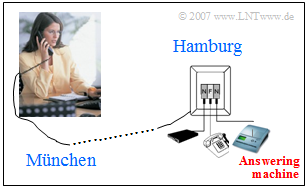Difference between revisions of "Aufgaben:Exercise 1.1Z: ISDN Connection"
From LNTwww
| Line 49: | Line 49: | ||
{{ML-Kopf}} | {{ML-Kopf}} | ||
'''(1)''' The <u>first two statements</u> are correct: | '''(1)''' The <u>first two statements</u> are correct: | ||
| − | * | + | *The speech signal ${q(t)}$ must first be converted into an electrical signal and then prepared for transmission. |
| − | * | + | *For ISDN the transmit signal is ${s(t)}$ digital. |
| − | '''(2)''' | + | '''(2)''' Correct are the <u>solutions 3 and 4</u>: |
| − | * | + | *The received signal ${r(t)}$ is always analog due to the unavoidable thermal noise. |
| − | * | + | *The message sink is the answering machine |
| − | * | + | *In an ideal transmission system $v(t) = {q(t)}$ should apply. |
| − | * | + | * Due to the additive noise term ${n(t)}$, the damping $\alpha$ and the running time $\tau$ but applies here: |
:$$v(t) = \alpha \cdot q ( t - \tau) + n(t).$$ | :$$v(t) = \alpha \cdot q ( t - \tau) + n(t).$$ | ||
| − | * | + | *By our definitions, this is a distortion-free system. |
{{ML-Fuß}} | {{ML-Fuß}} | ||
Revision as of 22:34, 11 August 2020
We consider the scenario shown in the picture:
A woman from Munich dials a number in Hamburg with her ISDN phone. However, she cannot reach the person she wants to talk to, so she leaves him a message on tape.
The distortion-free connection is fully described by
- a damping factor $\alpha$,
- a term $\tau$, and
- the current signal-to-noise ratio (SNR)
Notes: The task shall establish a relation between this real scenario and the functional units of a general message transmission system mentioned in Theorieteil .
Questions
Solutions
(1) The first two statements are correct:
- The speech signal ${q(t)}$ must first be converted into an electrical signal and then prepared for transmission.
- For ISDN the transmit signal is ${s(t)}$ digital.
(2) Correct are the solutions 3 and 4:
- The received signal ${r(t)}$ is always analog due to the unavoidable thermal noise.
- The message sink is the answering machine
- In an ideal transmission system $v(t) = {q(t)}$ should apply.
- Due to the additive noise term ${n(t)}$, the damping $\alpha$ and the running time $\tau$ but applies here:
- $$v(t) = \alpha \cdot q ( t - \tau) + n(t).$$
- By our definitions, this is a distortion-free system.
